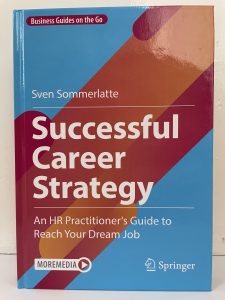Introduction
Performing at top leadership level requires discipline to ensure physical and mental wellbeing. This is comparable to sports athletes, who follow a rigorous diet, who ensure they have sufficient sleep and who require a personal environment that ensures support. Let’s see how Miriam managed to grow into significant leadership responsibilities and what her key success factors were for that.
Miriam’s story
Miriam had completed her studies successfully but did not stand out. She made a decent career start in the international sales department of an event organizer. Her ambition was initially not particularly high, even if she had always been willing to go the extra mile when necessary. She was married and had a daughter. One day the VP Commercial Operations invited her for a meeting. She learned that her boss had been asked to leave because of low performance. She was given the opportunity to take that responsibility ad-interim, while an external recruitment would be started. An attractive bonus was offered to her. Miriam accepted, even if she felt quite overwhelmed.
Miriam reflected with a coach on how to tackle that challenge. She had to step up vis-à-vis her peers to take the team leadership role. People management at that level was a new experience for her. She was accepted, because of her modest approach, emphasizing that her intention was to help the team in this transition phase and asking also for help from her team members. This came across very well. But the situation was much more challenging than she had expected. Several markets were underperforming, and the company had been losing market share for the past 3 years. Miriam developed an action plan with her leadership team. This was done in a very participative way, which was new. The former department head was much more in a command-and-control mode and had never involved the team in strategic topics. He had rather tried to hide the problems instead of asking for help.

Miriam started to really enjoy this role. They managed to acquire a couple of significant new clients. The team was striving under her leadership. Success triggered additional business opportunities and after nine months a real turn-around had been accomplished. The closing of the year became a real celebration because the objectives had been overachieved. Miriam ensured that the entire team was rewarded for that.

Every day was a learning experience for her. Defining strategic direction, making difficult choices, allocating resources between projects, responding to customer complaints that were escalated to her, understanding the financial reports, and optimizing her operational dashboard, speaking in public, coaching team members, setting an inspirational vision and fighting to get support from the company for some important investment decisions were completely new requirements for her. She was super motivated and engaged but was also waiting for the external recruitment to be closed, because she felt that she was massively stretching her physical capabilities. Stress caused lack of sleep when she woke up early to work on urgent topics. At home, the harmony was sometimes at stake when she had to prioritize work. Even psychologically this became a drain, and she was conscious that there was no option to continue like that much longer.

To her great surprise, the annual performance meeting with her boss was not focused on her past performance, but the questions were all about her career aspiration. She learned that the external recruitment had not been successful, because the selected candidate finally accepted a retention offer from his company. There was no alternative candidate. The VP Commercial Operations shared with her two options he was considering: starting a new recruitment and asking her to continue the interim or …. nominating her! This came as a complete surprise to Miriam. She was very flattered by the trust that the organization was showing. But simultaneously she felt that this task was too heavy for her. Miriam was transparent about that with her line manager. He understood her situation and gave her time for reflection and the support of a business coach. They agreed that she would for the time being pursue her interim role and that they would make a decision jointly after 2 months.

The coaching was extremely helpful for Miriam. She understood that this extended responsibility required some choices on her side. Just continuing to operate as she did before was not possible. If she wanted to take that sales leadership role, changes on the private and professional side were necessary. After consultation with her family, she opted to accept the leadership job. Miriam used part of her salary increase to get support for the house and day care for her daughter. Her partner accepted to make a trade off in terms of his own career to be able to support the family more. Miriam also started to work out every second day. She needed that space to vent and relax. She also enjoyed the competitive aspects of sports and joined a running group. During this time, she also changed her diet and her sleeping habits. She was much more rigorous to ensure a minimum of 7 hours of sleep every night. Finally, she agreed with her manager that a project manager would be dedicated to support her in terms of analysis, action plan monitoring, meeting organization and travel coordination.

Miriam sometimes felt that she was flying. She observed that her physical capabilities were much stronger. That made her stronger also in the professional environment. The strict life-work schedule was like a backbone for her. She was now able to cope with much greater level of pressure at work, while still being available for her team when they needed her. People were looking up to her, especially younger female professionals. This motivated Miriam even more. She was on an intensive learning journey and explored new way of leading the business, making bold decisions, learning more about herself as a leader and stepping up in terms of sales management.

Her partnership was the main factor of her ability to perform at that level. She felt fully supported. The time she had with her family were moment where she could resource herself. It became increasingly clear to her that this was the most important part in her life, even if the rest (business, sports, role modeling, …) gave her deep satisfaction as well. The couple agreed to expand the family and they had another daughter and a boy.

Miriam had in the meanwhile made 2 additional career steps and was in the board of directors. She was now recognized in the industry as a top talent and high performer. She had received several offers but decided to stay with her employer. She was given the perspective to become CEO of that company. A management magazine had conducted a long interview with her where she had shared her success story. The article was published, and she was described there as a true corporate athlete who could combine family, top leadership, and competitive level sports.

Miriam was proud of that but thought by herself: I was not born a corporate athlete; I became a corporate athlete. She knew about the choices she had made and that these had been indispensable for her career journey.
What can we learn from Miriam’s story?
The ability to perform at the highest level is certainly not given to everybody. But even those who have the capabilities to operate in the league of top performer must create the conditions for their success. Physical and mental wellbeing are essential requirements for that. Healthy food, sufficient sleep, a balanced family life, support resources are the key ingredients to become a corporate athlete.
More information in my book:
Sven Sommerlatte : Successful Career Strategy – An HR Practitioner’s Guide to Reach Your Dream Job (Springer, June 2023). ISBN: 978-3-662-66790-3

